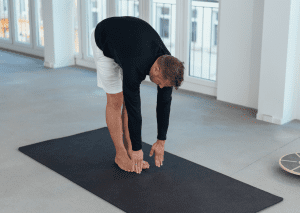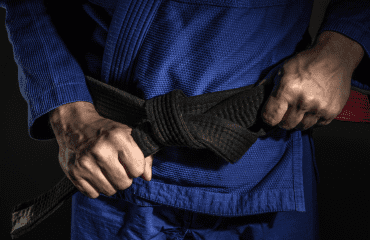
Stretching plays a vital role in Brazilian Jiu-Jitsu (BJJ). It not only improves flexibility but also enhances performance, helping us navigate the dynamic nature of this martial art. Whether you’re a beginner exploring jiu-jitsu schools or a seasoned practitioner training for a higher belt, a proper stretching routine is essential for injury prevention and maximizing your potential on the mat. Including a variety of stretches ensures you target different muscle groups effectively. Make sure to focus on stretches that keep your leg straight for optimal results.
Why Is Stretching Essential for Jiu-Jitsu Practitioners?

Stretching isn’t just about increasing flexibility; it’s about optimizing movement and reducing the risk of injuries during ground fighting. In jiu-jitsu training, the body undergoes intense pressure, requiring flexibility and strength. Stretching helps loosen tight muscles, improve blood flow, and enhance performance.
Proper stretches also target different muscle groups, ensuring a full range of motion. Whether focusing on the left leg during a stretch or maintaining a straight-line posture, these techniques prepare you for better execution on the mat.
What Are the Different Types of Stretching for Jiu-Jitsu?

Static Stretching vs. Dynamic Stretching
Static stretching involves holding a stretch for a prolonged period, which is ideal after training to relax the muscles. Dynamic stretching, on the other hand, uses movement to prepare the body for action, making it crucial for pre-class warm-ups in jiu-jitsu classes. Adding hamstring stretches during static routines can alleviate stiffness after training. For dynamic sessions, include lunges to engage different muscle groups effectively.
Controlled Articular Rotations and Their Benefits
This form of movement improves joint health and mobility, a necessity in martial arts like BJJ. Practicing controlled rotations for the shoulders, hips, and spine helps enhance performance on the mat. Rotations involving the right arm and left hand can improve upper-body coordination. Always keep a straight line in your posture to avoid strain.
How to Incorporate Stretching in Your Daily Regimen
Consistency is key. A mix of static and dynamic stretching routines ensures optimal flexibility. Incorporating these stretches into your daily practice is the best way to reduce injury risks while training with partners. Focus on transitions, like moving from the left knee to the right leg, to avoid imbalances.
Switching between stretches for the left ankle and right foot can enhance mobility and stability over time. Use a seated knee position to achieve deeper hip stretches.
How Does the Butterfly Stretch Improve Hip Mobility?

Technique for Performing the Butterfly Stretch
Sit on the mat with your feet together and knees bent outward. Gently press your knees toward the ground. This simple stretch is excellent for opening the hip region. Keep your foot flat to ensure proper alignment.
Benefits for the Groin and Hip Region
The butterfly stretch targets the groin and inner thighs, areas often stressed in jiu-jitsu. Improved hip mobility aids in defensive techniques like shrimping and guard recovery. Including this stretch can enhance the full range of motion needed during transitions.
Common Mistakes to Avoid While Performing This Stretch
Avoid bouncing your knees or forcing the stretch. The goal is controlled, steady pressure to release tension effectively. Incorporating this into your routine can help you avoid injuries. A great stretch variation involves gently pulling the knees closer to the ground for deeper engagement.
What Is the Wide Leg Adductor Stretch and How Does It Help?

Step-by-Step Guide to the Wide Leg Adductor Stretch
Sit with your legs extended in a wide “V” shape. Lean forward gently, keeping your back straight. You’ll feel the stretch in your hamstrings and inner thighs. Keeping each leg straight helps target deeper muscles, and alternating focus on the left leg and right leg ensures balance.
Key Benefits for Inner Thighs and Hamstring Flexibility
This stretch improves flexibility in the inner thighs and hamstrings, making movements like leg locks and sweeps more fluid during BJJ classes.
Adding a crossed-leg position during cooldowns can further enhance your stretching routine. Stretching in this way engages different muscle groups, aiding overall performance.
How to Integrate It into Your Stretching Routine
Switch legs between focusing on the left leg and the right leg to ensure balanced flexibility. Use this stretch after practice to cool down and recover efficiently.
Can the Lying Half Spinal Twist Improve Your Thoracic Spine Mobility?

Proper Form and Technique for the Lying Half Spinal Twist
Lie on your back, extend one leg, and bring the other leg across your body toward the ground. Keep your shoulders flat and use your opposite hand to deepen the stretch.
Holding this stretch with a straight line from shoulder to knee maximizes its effectiveness. Focus on keeping your left hand grounded to maintain alignment.
Benefits for the Upper Back and Spinal Flexibility
This stretch targets the thoracic spine, shoulders, and hips. It helps you maintain mobility during grappling and reduces strain on the glute stretch and hip region.
Engaging the right arm during this stretch improves posture and supports proper breathing. Rotate gently to ensure you get the entire stretch.
How It Relieves Tension in the Lower Body
The lying half spinal twist is a great stretch for releasing tension in the lower back, especially after intense training sessions. This stretch also helps strengthen the hamstring stretch for better lower-body control.
How Can Neck Stretches Prevent Injuries in Jiu-Jitsu?

The cervical spine often bears significant strain during BJJ training. Incorporating gentle neck stretches enhances flexibility and reduces the likelihood of strains or stiffness. Add a rotation stretch to loosen the neck and ensure safe grappling moves.
Why Should You Focus on the Hip Flexors in Your Stretching Routine?

Best Stretches for Hip Flexors in Jiu-Jitsu
Hip flexor stretches, like the kneeling lunge, help improve mobility for techniques involving guard passing and sweeps.
How Tight Hip Flexors Affect Jiu-Jitsu Performance
Tight hip flexors can limit your ability to transition smoothly, impacting overall performance.
Dynamic Movements to Enhance Hip Flexibility
Incorporate movements like high knees and lunges to loosen tight muscles. Focusing on the left ankle and right foot alternately during stretches improves balance and mobility.
What Are the Benefits of the Leg Cradle Stretch for BJJ Athletes?

The leg cradle stretch enhances hip flexibility and prepares the body for intense BJJ training. It also targets the glutes, reducing strain during transitions and guard work.
How Does the Half-Spinal Twist Improve Flexibility in the Spine?

Proper Technique for the Half-Spinal Twist
Sit with one leg crossed over the other and twist your torso toward the bent knee. Keep your back straight and maintain a steady breathing rhythm. Position your right arm behind you for support while using your left hand to gently press against the bent knee, deepening the stretch. Ensure your foot flat stays grounded to provide stability and maintain a straight line from your hips to your shoulders.
Benefits for the Thoracic and Lumbar Spine
This stretch enhances spinal flexibility, allowing better posture and movement during matches. It also helps release tension in the glute stretch, further improving mobility for transitions. By engaging both the thoracic and lumbar regions, this stretch promotes a full range of motion essential for grappling techniques.
Tips to Avoid Common Errors
Avoid over-twisting, as it can lead to injury. Focus on controlled movements and alignment. Keep your left knee pointed upward to maintain proper posture throughout the stretch. Remember to switch legs to ensure balanced flexibility on both sides. Adding a slight pull with your hands can help deepen the stretch without risking strain.
How Can Ankle Mobility Exercises Improve Groundwork in Jiu-Jitsu?

Ankle mobility is vital for stability during transitions and sweeps. Simple stretches like ankle rolls or calf stretches enhance balance and support during ground techniques. Incorporating exercises that focus on the left ankle and right foot individually helps correct imbalances and improve overall control. Maintaining a foot flat position during certain stretches can also reinforce stability and reduce the risk of injury during intense sessions.
What Are the Best Stretches for Upper Body Flexibility in Jiu-Jitsu?

Torso Stretch Techniques
Torso stretches improve core mobility, aiding in guard retention and escape techniques. Incorporating rotation stretches into your routine helps strengthen the core while enhancing spinal flexibility. Keep your torso aligned in a straight line during these stretches to maximize effectiveness and reduce the risk of injury.
Stretches for the Shoulders and Chest
These stretches reduce stiffness, especially after long sessions of GI grappling. Focus on maintaining a shoulder-width position during chest stretches to target the muscles effectively. Adding gentle movements using your right arm and left hand can further improve the stretch, enhancing mobility in the upper body.
Importance of Upper Body Flexibility in Grappling
Upper body flexibility is essential for smoother transitions and executing techniques with precision. Using stretches that engage different muscle groups, such as the shoulders and upper back, ensures balanced flexibility. A flexible upper body also helps you avoid injuries and maintain control during intense sparring sessions.
A flexible upper body ensures smoother transitions and reduces the risk of overuse injuries.
What Are Dynamic Stretches and How Do They Prepare You for Training?

Key Dynamic Stretches for Pre-Class Warmups
Incorporate exercises like arm circles, hip swings, and walking lunges to activate multiple muscle groups. Adding movements like high knees and leg swings can further enhance flexibility and engage different muscle groups. Ensure you keep a straight line in your posture during these exercises to maximize their effectiveness.
Benefits of Dynamic Movements for Blood Flow and Muscle Activation
Dynamic stretches increase blood flow, preparing your body for the intense demands of jiu-jitsu. These movements help improve mobility in areas like the left ankle and right foot, which are critical for balance during ground techniques. Activating these areas ensures a full range of motion during grappling.
How Dynamic Stretches Prevent Injuries
Prepping your body with movement-based stretches reduces the risk of strains during sparring or drills. Dynamic movements also allow you to switch legs, ensuring both sides of your body are equally warmed up. Incorporating these stretches into your routine can help you avoid injuries and improve overall performance on the mat.
Why Should Every Jiu-Jitsu Practitioner Have a Stretching Routine?

A consistent stretching routine tailored to your needs enhances performance and ensures longevity in Brazilian Jiu-Jitsu. It’s a vital part of training that helps practitioners stay at their peak. Regular stretches, such as a hamstring stretch or a glute stretch, target different muscle groups, ensuring balanced flexibility and strength.
Incorporating movements like a rotation stretch can help maintain a full range of motion, reducing the risk of strain during intense sessions. Whether focusing on the left leg or the right leg, a proper routine helps you improve overall mobility and avoid injuries.
How Can You Start Incorporating These Stretches into Your Jiu-Jitsu Routine?

Start incorporating these stretches into your daily routine to enhance flexibility and reduce injury risks. At NOCO Jiu Jitsu and Self Defense, we emphasize the importance of proper warm-ups and cool-downs in our programs. Visit our BJJ academy to learn more about integrating these techniques into your practice. Call us today for more information!
We’ve explored the best stretches for improving flexibility and performance in jiu-jitsu. By adding these stretches to your routine, you can maximize your training potential, reduce injuries, and maintain peak performance. Whether you’re just starting out or training with experienced black belts, a good stretching regimen is the foundation of success.
Frequently Asked Questions:
- Why is stretching important for Brazilian Jiu-Jitsu practitioners?
Stretching is vital for improving flexibility, enhancing performance, and reducing the risk of injuries during training and sparring sessions. - What are the best types of stretches for pre-training in Jiu-Jitsu?
Dynamic stretches, such as lunges, high knees, and hip swings, are ideal for warming up before training. - How does the butterfly stretch help in Jiu-Jitsu?
The butterfly stretch improves hip mobility and targets the groin and inner thighs, aiding in defensive moves like shrimping and guard recovery. - What are controlled articular rotations, and why are they beneficial?
These rotations improve joint health and mobility, especially in the shoulders, hips, and spine, which are critical for effective movement on the mat. - Can ankle mobility exercises improve my groundwork techniques?
Yes, ankle mobility exercises like ankle rolls and calf stretches enhance stability and balance during transitions and sweeps. - How can I incorporate a stretching routine into my Jiu-Jitsu training?
Add a mix of static stretches after training for recovery and dynamic stretches before training to prepare your body. Focus on alternating stretches for both legs to maintain balance. - What common mistakes should I avoid when stretching for Jiu-Jitsu?
Avoid bouncing during static stretches and over-twisting in rotational stretches. Always use controlled movements to prevent injuries. - Why is upper body flexibility important in Jiu-Jitsu?
Upper body flexibility improves transitions, reduces stiffness, and supports effective execution of techniques like guard retention and escapes. - How often should I stretch to see improvements in my flexibility?
Stretching daily or at least after every training session is recommended to maintain flexibility and reduce muscle stiffness. - What role do hamstring stretches play in Jiu-Jitsu?
Hamstring stretches improve leg flexibility and mobility, which is essential for executing sweeps, escapes, and guard transitions.




